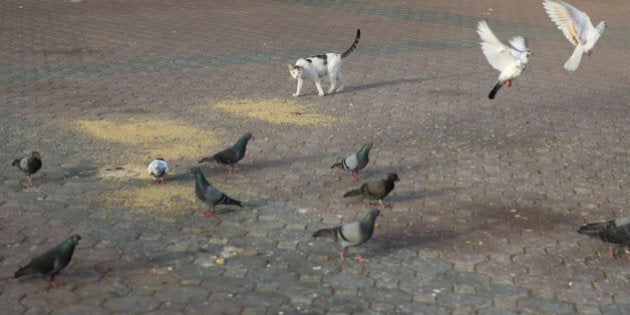
I love cats, if you know me well, you know this to be very true. I am a cat owner and live in a community where there are hundreds of cats, some of them roaming the neighbourhood and others, like mine, who sit in the window peering out with typical cat-like enthusiasm.
But I also love birds and was surprised to learn that in Canada, both bird and cat populations are in trouble.
Did you know some bird species have declined by over 90 per cent? This is an alarming statistic!
Declines can be attributed to habitat destruction and climate change, and an estimated 270 million birds die each year due to human factors such as collisions with windows and buildings, and hunting by cats.
Cats, both pet and feral, cause 75 per cent or approximately 200 million bird deaths a year. The feral cat population is growing rapidly and shelters can't keep pace. In 2011, more than 50,000 cats were euthanized because homes could not be found.
In comparison with dogs, twice as many cats are dumped in shelters and less than five per cent of cats are returned home. It is a sad statistic that more than 1,300 dead cats were collected on the streets of Toronto in just one year. Outdoor cats are exposed to a variety of threats, including diseases like feline leukemia, parasites, vehicle collisions, malicious humans (who poison them) and fights with wildlife and other cats.
The situation is so dire that Margaret Atwood is penning a series of graphic novels to help bring awareness to the issue. Atwood is part of a larger awareness campaign with Nature Canada called "Keep Cats Safe and Save Bird Lives."
When I spoke to Eleanor Fast, the Executive Director for Nature Canada, she said. "while cats' independent natures might lead some people to treat them like something between pet and wildlife, we owe them the same level of care we give our dogs, keeping a cat from roaming freely, while providing adequate stimulation is what they deserve. Therefore, we are challenging cat owners to take Nature pledge in support of protecting both cats and birds."
Nature Canada's initiative brings to light the controversial and ongoing issue of feral cats in Toronto.The Toronto Humane Society stresses the importance of keeping cats indoors. They are on the front lines of this problem and see the consequences first hand. According to Tegan Buckingham, Manager, Public Relations at the Toronto Humane Society, "a long-term, sustainable solution requires culture change; and that is possible - where once stray dogs roamed the streets, today they are beloved family members. Yet, while many people view cats as part of their family, too many unaltered cats are allowed to roam, or abandoned to fend for themselves, leading to increasing numbers of feral cats living difficult lives in our streets and parks."
Sarah May, Foster Coordinator at Toronto Cat Rescue echoes that sentiment and adds "unfortunately not every cat is lucky enough to have a home. Feral cats are cats that have lived all of or most of their lives outdoors, often living as groups (called colonies) in urban and rural areas. Unlike your spoiled house cat, feral cats have not been socialized or raised in close proximity to people and for this reason, they are not happy as house pets. For feral cats we believe - like most rescue organizations and humane societies across North America - that Trap-Neuter-Return-Manage (TNRM) is the best solution.
Through TNRM programs, feral cats are trapped, spayed/neutered and returned to their colonies, where they are fed daily and provided outdoor winterized shelters by caring individuals. By neutering these cats, we are getting to the route of the problem and preventing more kittens from being born into the harsh outdoor life, while also improving the health and well-being of the colony. Additionally, many of the nuisance behaviours (such as spraying and fighting) that make feral cat colonies undesirable to communities are greatly reduced when the colony is neutered and well managed."
Trap-Neuter-Return-Manage has been practiced for over 20 years in the UK, South Africa and Denmark. After 1-3 years of TNR colony sizes decrease by 16-32 per cent (Natoli 2006). TNR is an effective long term strategy to stabilize or modestly reduce the size of feral cat colonies as well as improve the health of these cats (Levy, 2003).
After talking to both agencies, it's evident that there is a strong cultural belief that cats can fend for themselves outdoors, yes some of them are tough, but according to the Toronto Humane Society, "in 2012, while 65 per cent of stray dogs at Toronto Animal Services found their way home, less than five per of stray cats did."
Hopefully, Nature Canada's "Keep Cats Safe and Save Bird Lives" will raise awareness and get people talking about this issue. After-all, don't we all have the responsibly to keep our pets safe, happy and healthy. And can you image if we felt the same way about our dogs? What kind of society would we have if there were thousands of dogs roaming the streets?
For more information about this campaign or to see a full list of national, regional and local partners go to catsandbirds.ca or naturecanada.ca.
Follow HuffPost Canada Blogs on Facebook